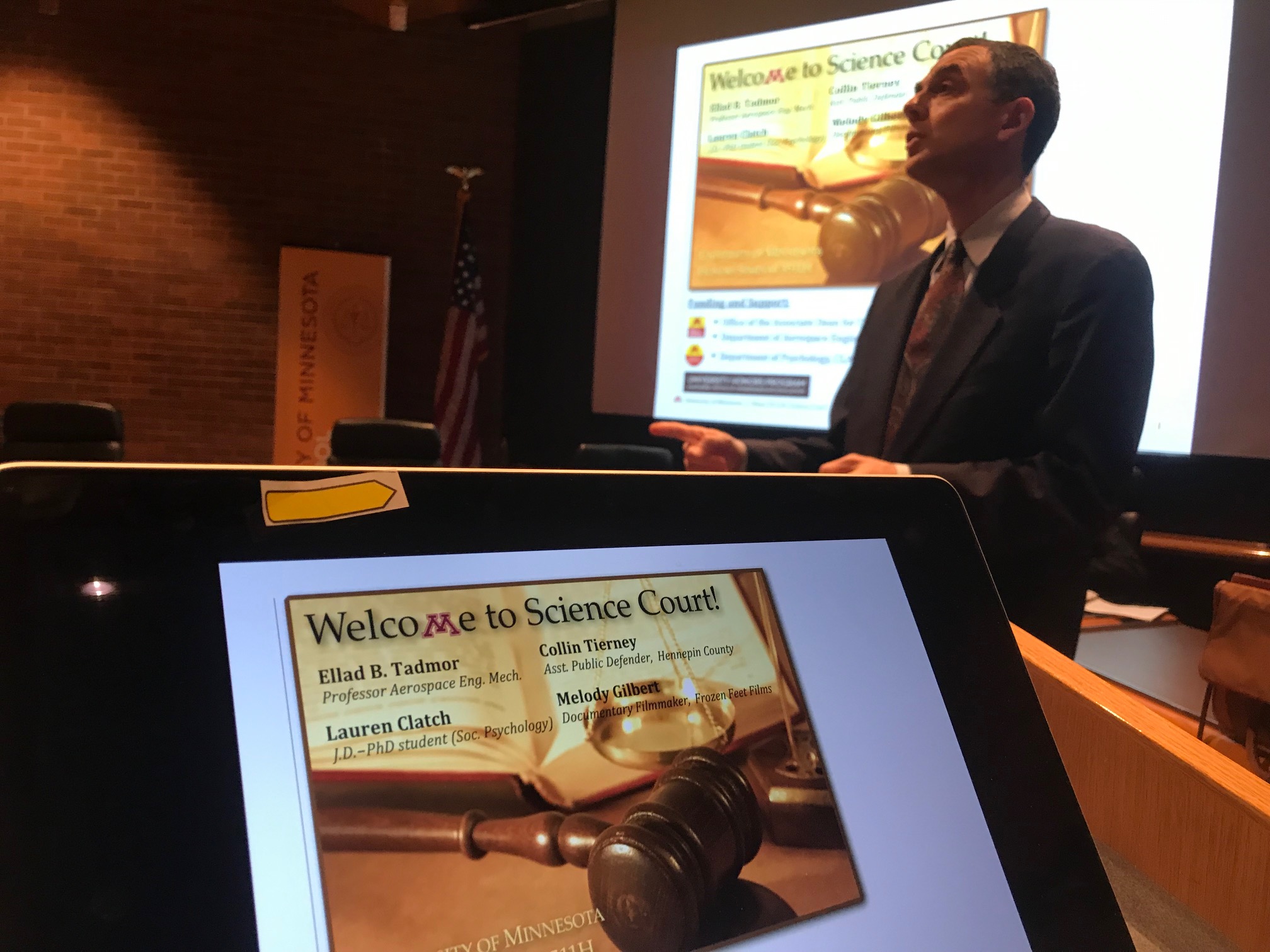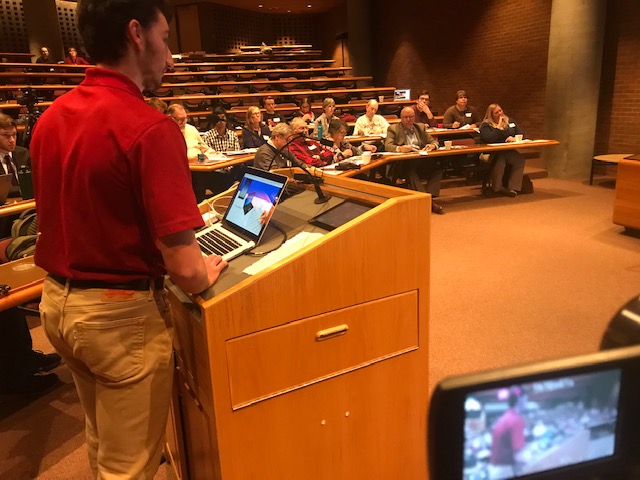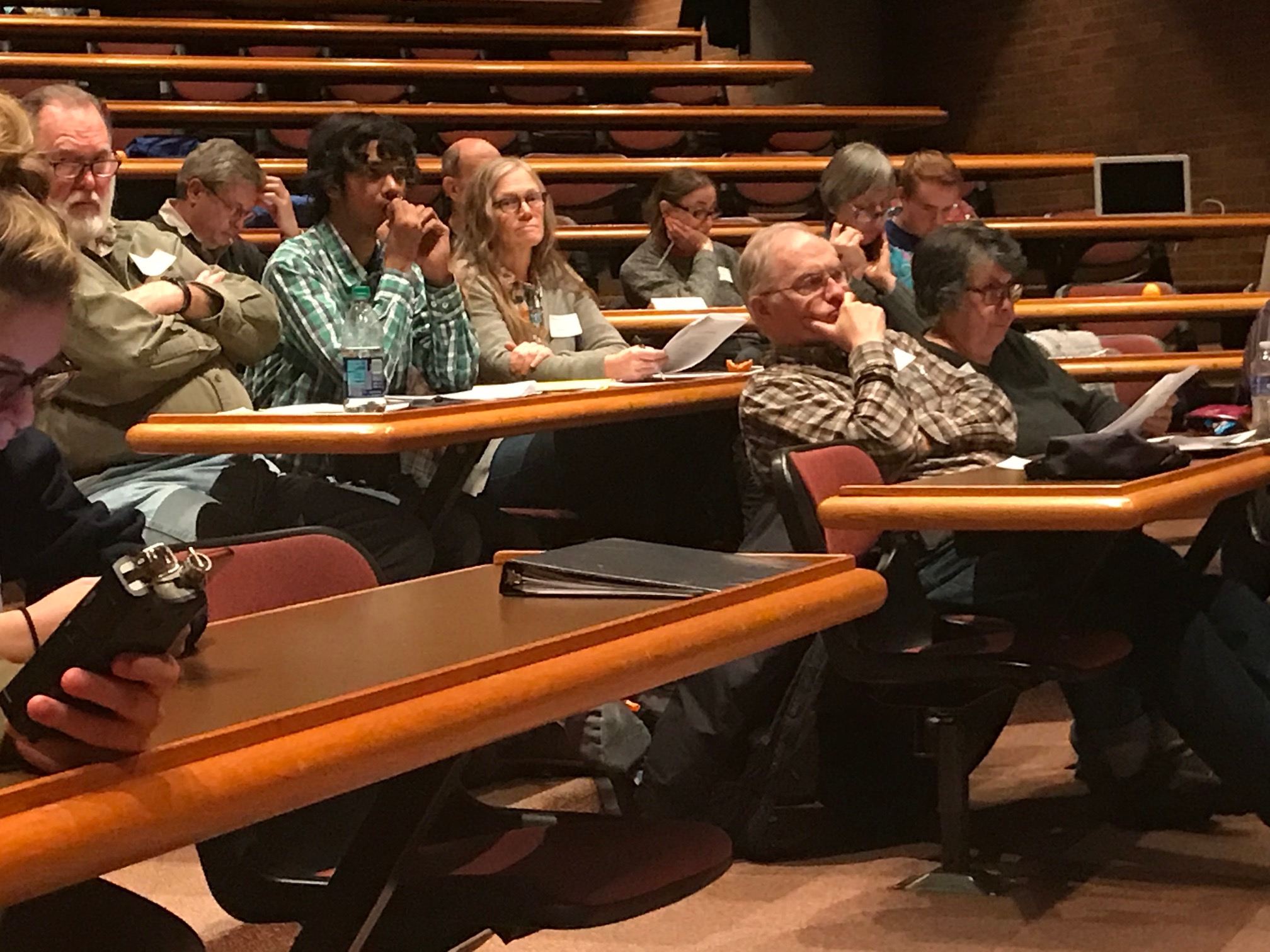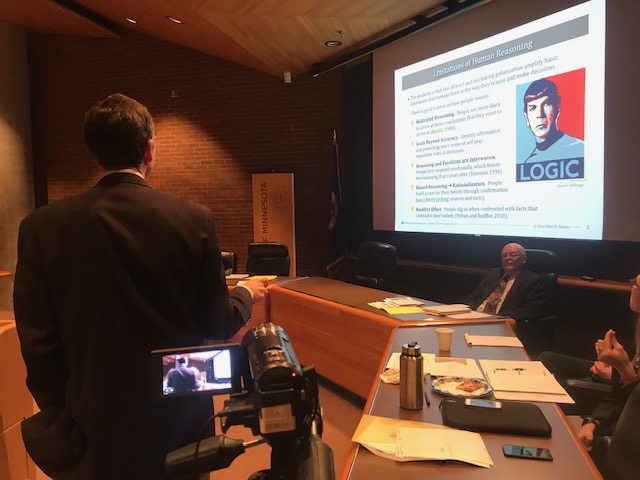Watch a video recap of the first day of the SciCourt trial. Also, find out why the members of the jury volunteered to be on the jury.
Listen to the Podcast by Luke Diamond to hear a recap of Day 1 of SciCourt!
You’ve seen the videos. You've heard the podcast. Now, read the complete story that gives you all the details about the first day of the SciCourt Trial. After 12 weeks of research, practice and preparation, SciCourt has finally reached the courtroom!
Minutes before the trial started in room 25 of Mondale Hall, Legal Team member Kyle Smith said,
“I am excited to see how this turns out because we have been working on this for a whole semester, but I still have those pregame jitters going through my body right now.”
The trial began with Professor Ellad Tadmor giving an overview of what SciCourt is and why it is relevant in today's society. Tadmor explained how trust in the government is at an all time low, that people are voting more and more based on political parties, and how the US is actually a flawed democracy based on the democracy index. SciCourt hope to help with these issues by promoting civil discourse. After 10 years of thinking about a class like this, Tadmor said the time to do this class was now.
After that, SciCourt judge Bill McGinnis explained to the volunteer jury their role in the trial, and how the trial would proceed.
- Opening Statements from both the PRO and the CON side of the issue
- A Science Team member (also known as a Domain Reporter) would give their presentation to the jury
- The Legal Teams would get the chance to cross-examine the Science Team Member
- The Jury can questions, through the judge, to the Science Team Member
- This process will be repeated for all 7 domains
- Closing Statements from both sides
And so… it begins!

As the trial commenced, opening statements and four domains were presented.
Kali Kilmer presented the Opening Statement from the Pro 1:1 Tech Team. She highlighted the benefits of technology in educational environments including:
- How tech skills are becoming increasing more essential in our lives
- How technology can allow for more flexible teaching methods
Kylie Smith presented the Opening Statement for the Con Team. She highlighted some of the potential problems with 1:1 Tech, such as
- How this program only provides the technology and not other supporting resources
- If this program would actually improve student performance
Four out of the seven domains were presented during day one of the trial. Up first was Colin Bunner talking about how student performance is affected, including:
- A change in test scores depends on implementation. The effect of tech is very small but positive and reproduced over different groups of students.
- In one case, students transcribing a lecture did better on a post test
- But in another case, people who were able to take notes on paper meant that they could draw and spatial reasoning
- In regard to eText and print textbooks, the research showed no difference between them
- Other students off task (or multitasking) in the classroom affects the people around them just as much as if they themselves were doing it
During the cross examination of Colin, the Pro Team hit on how multitasking already happens in the classroom and we don't know how computers will contribute to that. The Con Team hit on how the percentages, on improving test scores, were not statistically significant.
Next up: Sam Moerbitz presenting on student technology skills:

- Tech in schools does increase proficiency in programs such as word, email, web browsers, etc.
- There was no statistical significance in wages between the students with laptops and those without
- Whether or not the student had a computer did not affect college enrollment
Not only did the legal teams ask questions highlighting aspects of the domain, the jury also asked some hard-hitting questions about the specifics of the research.
- What year was the data collected? Not just when it was published, but when was the data collected?
During a short break, one of the jury members said:
“I think this is an excellent process. I enjoy having the domain experts interviewed by both sides and everybody is extremely well prepared. I think it's well organized.”
Next up: Lydia Fess presenting research on student physical health.
Fess made sure to mention that her results were correlational not causational. This means that although two things happened, we know they are related but not if one caused the other
- With each additional amount of screen time a greater percent of participants had some form of metabolic syndrome
“Tech significantly correlated with physical issues”
- More TV time affected cardiorespiratory fitness
- Overall more screen time related to worse physical health
On cross examination, the Pro Team brought up how the research does not prove that screen time causes a decrease in physical health on that they are related and how sedentary behavior would not necessarily increase if 1:1 Tech was implemented. The Con Team reiterated the relationship between screen time and health issues.
The last Science Team Member to present their domain on Day One was Ryan Jones talking about student mental health.
- Adding screen time seemed to have a negative effect on mental health
- Over time showed a little to no effect on mental health outcomes (but it did have a little effect)
- Cannot conclude that screen time causes mental health issues just that they are related somehow

The Pro Team highlighted how we don’t know how the two are related and that the studies did not differentiate between recreational and non-recreational screen time. The Con Team highlighted how mental health and screen time affected people in lower socioeconomic standings more.
Once all the domains were presented and the first day of trial was officially completed, we got the chance to talk to a few jurors and get their first impressions of SciCourt:
“I thought it was interesting. I liked that we looked at objective studies, and then the examination and cross examination of those studies as looking at what the truth is and what are the facts so that when we as a jury try to come to a conclusion - we have a lot of good information that way.”
“It's really nice to just remain completely open to not draw any conclusions because we are rarely asked in a situation to just take in information and let it sit and wait for more, so I am really liking that process.”
As he was packing up to leave the “courtroom,” Professor Tadmor said he was thrilled. “I’m very excited about how it went today. It’s a dream come true. Looking forward to the conclusion of the trial next week!” And so are we.
Next week, part 2 of the trial takes place on Tuesday, Dec. 4th at 6:00 pm in the University of Minnesota Law School (Mondale Room 25).
The jury will deliberate on Thursday and the decision will be announced the following Tuesday.
Of course, we will keep you posted, but you can also follow us on social media on Facebook, Twitter, and Instagram.
